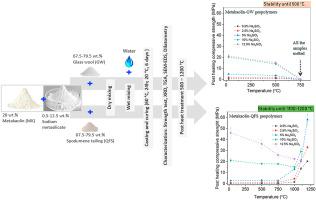Cement and Concrete Composites ( IF 10.8 ) Pub Date : 2020-08-28 , DOI: 10.1016/j.cemconcomp.2020.103792 Patrick N. Lemougna , Adeolu Adediran , Juho Yliniemi , Arnold Ismailov , Erkki Levanen , Pekka Tanskanen , Paivo Kinnunen , Juha Roning , Mirja Illikainen

|
This paper deals with the synthesis and thermal stability of one-part metakaolin geopolymer composites containing high volume of spodumene tailings (Quartz Feldspar Sand; QFS) and glass wool (GW). One of the objectives of the study was to prepare materials encompassing a maximum amount of waste streams with some potential thermal stability. Several compositions were prepared with sodium metasilicate anhydrous (Na2SiO3) wt.% of 0.5, 2.5, 5, 10 and 12,5. The one-part metakaolin geopolymer composites were cured at 60 °C for 24 h and the mechanical properties were assessed at 7 days and after post-heat treatment at 500, 750, 1000, 1100 or 1200 °C. X-ray diffraction, dilatometry, scanning electron microscopy and thermogravimetry analyses were used to study the stability of the prepared geopolymer composites until 1100–1200 °C. The results showed that more than 20 MPa compressive strength could be achieved with metakaolin geopolymer composites containing only 20 wt% of metakaolin. Metakaolin-GW geopolymer composites were stable up to 500 °C. Meanwhile, their counterparts containing QFS were stable up to 1100–1200 °C; samples prepared with higher dosage of sodium (Na2SiO3 > 5 wt%) retained more than 50% of their initial strength after thermal treatment at 1100 °C. Interestingly, for dosages of Na2SiO3 ≤ 5 wt%, more than 300% increase of strength was observed after thermal treatment at 1100–1200 °C. The use of QFS limited the thermal shrinkage at mild temperatures (<1000 °C), but favoured densification and strength development at 1100–1200 °C.
中文翻译:

含有大量锂辉石尾矿和玻璃棉的偏高岭土地质聚合物复合材料的热稳定性
本文研究了含有大量锂辉石尾矿(石英长石砂; QFS)和玻璃棉(GW)的偏高岭土地聚合物复合材料的合成和热稳定性。该研究的目的之一是制备包含最大量废料流并具有一定潜在热稳定性的材料。用无水偏硅酸钠(Na 2 SiO 3重量百分比为0.5、2.5、5、10和12,5。一件式偏高岭土地质聚合物复合材料在60°C下固化24小时,并在7天和500、750、1000、1100或1200°C后热处理后评估机械性能。X射线衍射,膨胀计,扫描电子显微镜和热重分析用于研究所制备的地质聚合物复合材料在1100–1200°C之前的稳定性。结果表明,仅含偏高岭土20 wt%的偏高岭土地质聚合物复合材料可达到20 MPa以上的抗压强度。偏高岭土-GW地质聚合物复合材料在高达500°C的温度下稳定。同时,含有QFS的同类产品在1100-1200°C的温度下仍保持稳定。较高剂量的钠(Na 2 SiO 3 > 5 wt%)在1100°C热处理后保留超过其初始强度的50%。有趣的是,对于钠的剂量2的SiO 3 ≤5重量%时,热处理后,观察到强度的超过300%的增长,在1100年至1200年℃。QFS的使用限制了温和温度(<1000°C)下的热收缩,但有利于在1100-1200°C下致密化和强度发展。











































 京公网安备 11010802027423号
京公网安备 11010802027423号